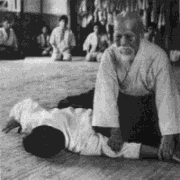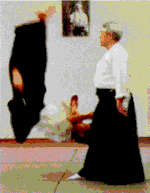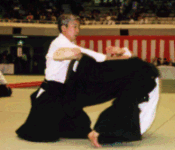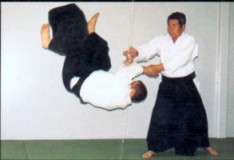

Emerging from a long period of obscurity in the East - during which time it was familiar only to relatively restricted circles - aikido has been called one of the most subtle and sophisticated of the martial arts, and - at its higher levels - an effective discipline for the development, integration and utilization of all man's powers, physical and mental (spiritual).
What may appear at first glance to be a unique method for efficiently defending yourself against any form or type of attack will reveal itself under careful scrutiny to be not only an effective method of self-defense derived from Japanese Bujutsu (warrior arts); in addition - and this is the element which interests many who are stangers to the traditional dojo, or practice hall - it is a Discipline of Coordination, a way of strengthening the mind and body, of fusing the individual's physical and mental powers so that he or she will emerge as a more fully integrated human being. The word, in fact, means, "method or way [do] for the Coordination or Harmony [ai] of Mental Energy or Spirit [ki].
The particular martial art method developed by Master Morihei Uyeshiba in Japan which he referred to as "aikido" combines practical self-defense movements taken from sword and spear fighting, jujutsu, aikijutsu and other ancient, more esoteric forms of the martial arts - with an emphasis from the very first moment of practice upon a characteristic centralization of thought and action, and the extension of mental energy or ki that makes this such an intriguing art.
 It is a unique method of self-defense equally adaptable to and effective against a single attacker or several. This practice also makes it possible for people of all ages and both sexes.
It is a unique method of self-defense equally adaptable to and effective against a single attacker or several. This practice also makes it possible for people of all ages and both sexes.
But why do we say that aikido is unique? Almost every martial art can claim to be an efficient means of self-defense and many can be safely practiced by old and young alike. How does aikido differ from all the others? which identify its practice, and the early as well as continuing emphasis placed upon them.
These include the following:
- Aikido, purely in its practical application, is an art of self-defense. It is entirely reflexive, and related ethically to defense against an unprovoked attack. There is no attack in aikido. When the techniques are applied by aikidoists who have achieved a certain degree of mastery in the art, they will leave no serious injury in their wake.
- There is the constant reference to the hara, or a man's "Centre" (i.e., center of gravity), as the point of concentration of energy; there is the predominance of references to ki, or "Inner Energy," as the particular form of energy to be employed. Finally, there is the interesting possibility of expanding these concepts and their relevance to areas outside the comparatively restricted world of the martial arts.
- There is the characteristic strategy (i.e., movements, displacements, techniques) peculiar to the art, and the emphasis upon circularity or "sphericity" in the application of that strategy.
 As a self-defense art, aikido recognizes that one individual attacked by another has the right (and, of course, usually the instinctive urge) to defend himself against that aggression.
As a self-defense art, aikido recognizes that one individual attacked by another has the right (and, of course, usually the instinctive urge) to defend himself against that aggression.
But how will he defend himself? This will depend upon the degree of his personal development. If he is still on a primitive level - mentally and/or physically - he may react wildly (often ineffectively); from the depths of his lack of preparation, he may clumsily inflict whatever damage he can upon his aggressor. Or, if skilled in one of the more deadly of the self-defense arts, he may cold-bloodedly proceed to seriously injure if not actually kill his attacker.
Using aikido properly however, an unjust and violent aggression can be neutralized swiftly and cleanly with demonstrable control over all the aspects of attack and defense - so that effective self-defense becomes possible without the necessity for inflicting serious injury upon an aggressor.
 In other words, aikido says that you should and must defend yourself, and supplies you with an extensive practice that will enable you to do so with optimum efficiency. But aikido also says that you must be responsible for not inflicting unnecessary damage upon your attacker. He is still operating on a lower level. You aspire to a superior level where your proven ability, well-earned self-confidence, and refinement of technique, will allow you to defend youself without resorting to the brutal methods so often taught as legitimate means of self-defense.
In other words, aikido says that you should and must defend yourself, and supplies you with an extensive practice that will enable you to do so with optimum efficiency. But aikido also says that you must be responsible for not inflicting unnecessary damage upon your attacker. He is still operating on a lower level. You aspire to a superior level where your proven ability, well-earned self-confidence, and refinement of technique, will allow you to defend youself without resorting to the brutal methods so often taught as legitimate means of self-defense.This definitely more difficult and therefore more sophisticated concept of self-defense, and the correlative control which must be developed in order to concretely achieve such aims in the practice of combat, becomes the testing ground for a developed aikido personality and the evidence of its existence. It is, therefore, in the very meaning attributed to the word "defense" that aikido differs from the other martial arts. This difference is graphically examined in the ethics of the art.
This excerpt was taken and edited from AIKIDO AND THE DYNAMIC SPHERE by A. Westbrook and O. Ratti